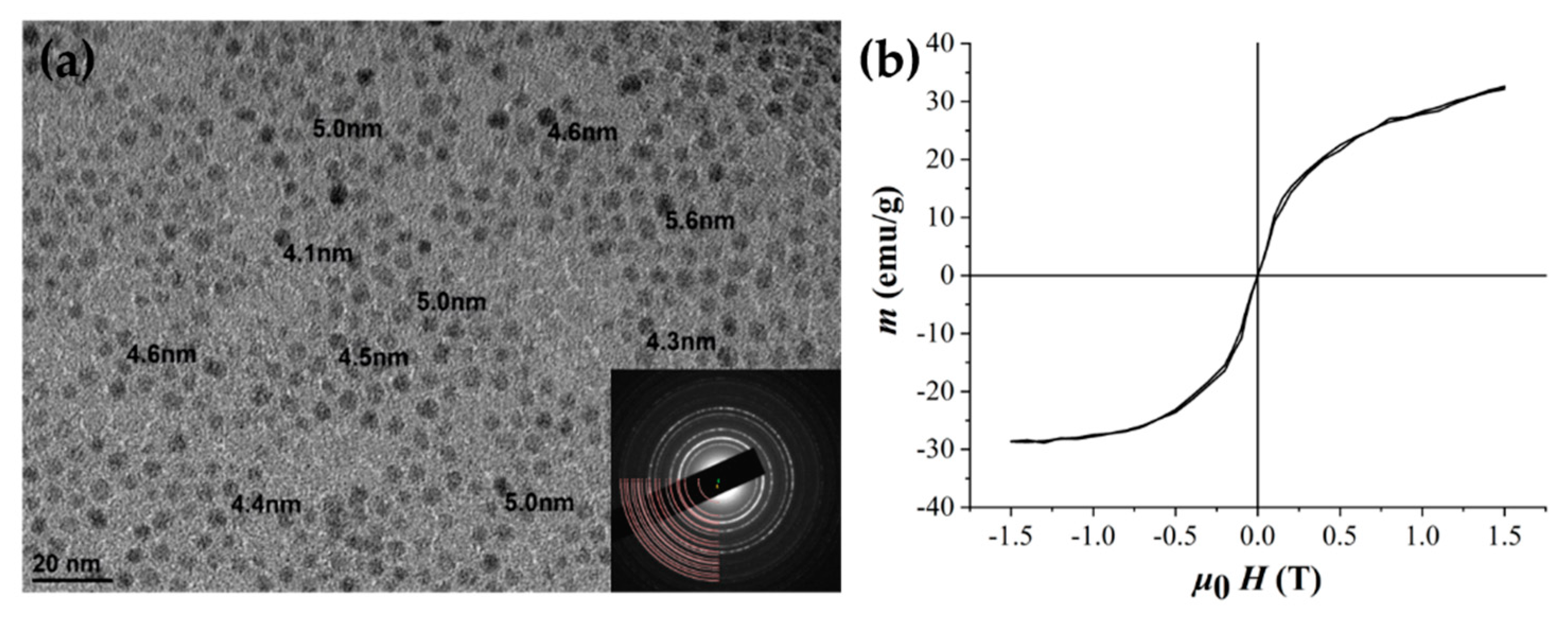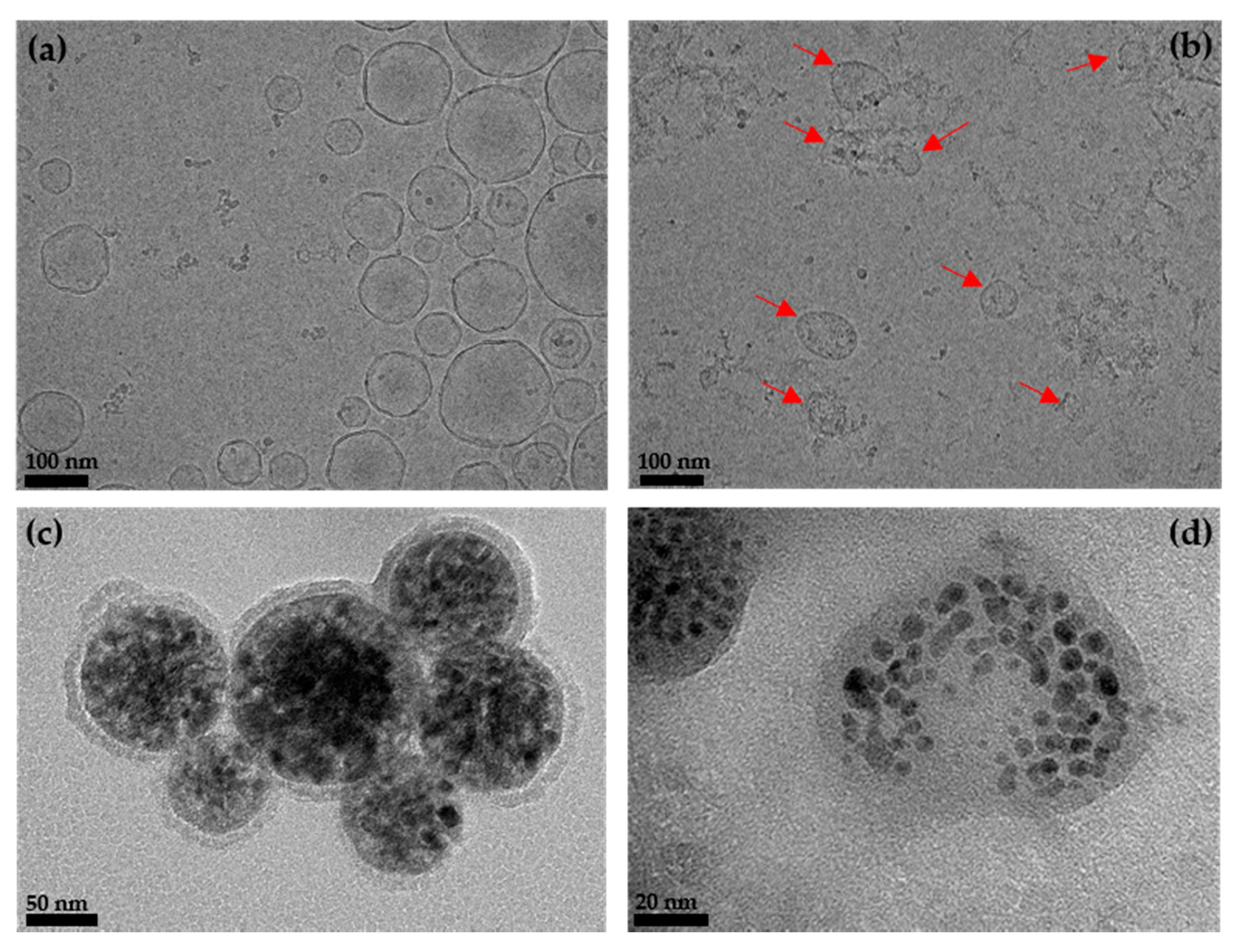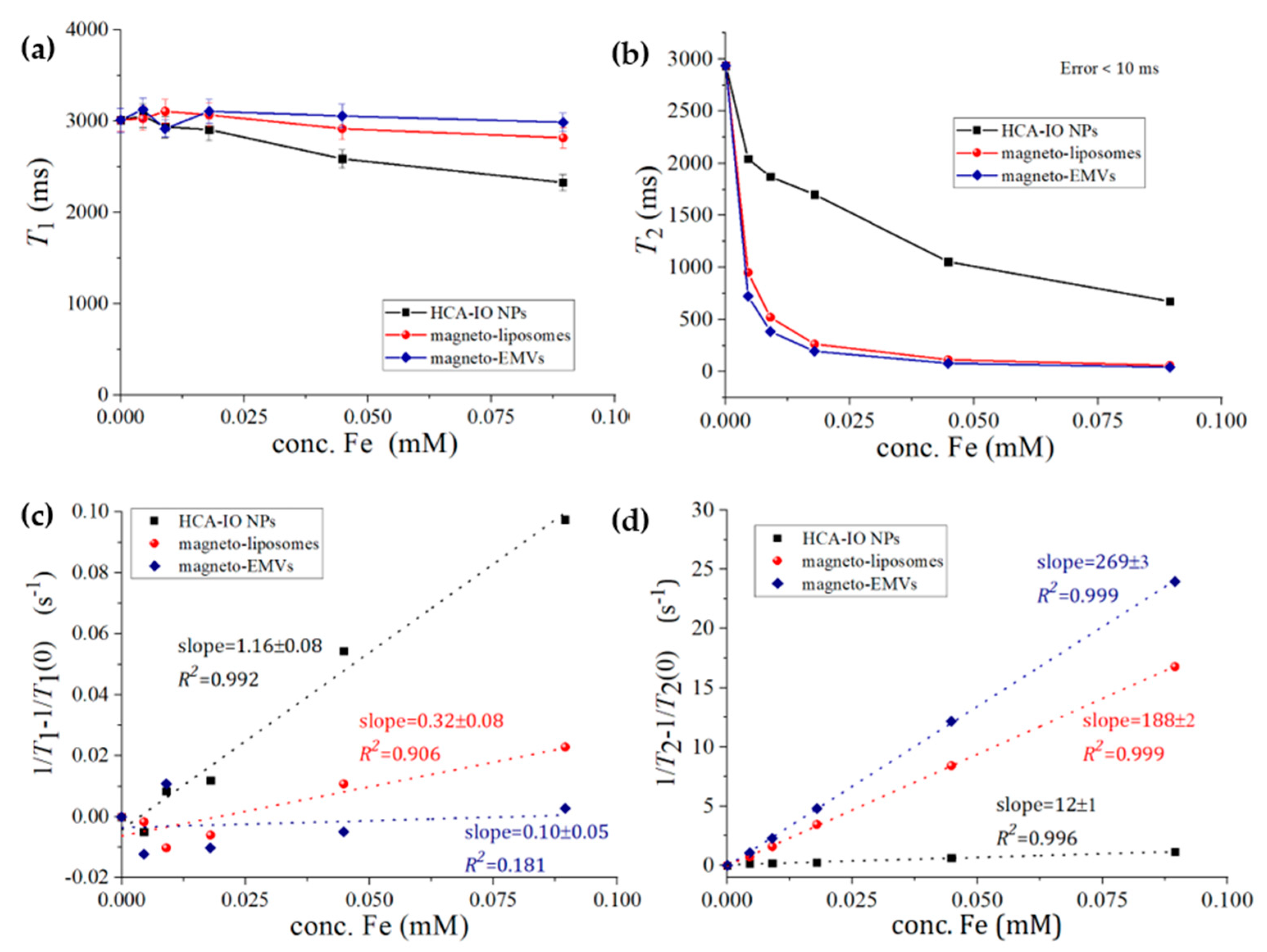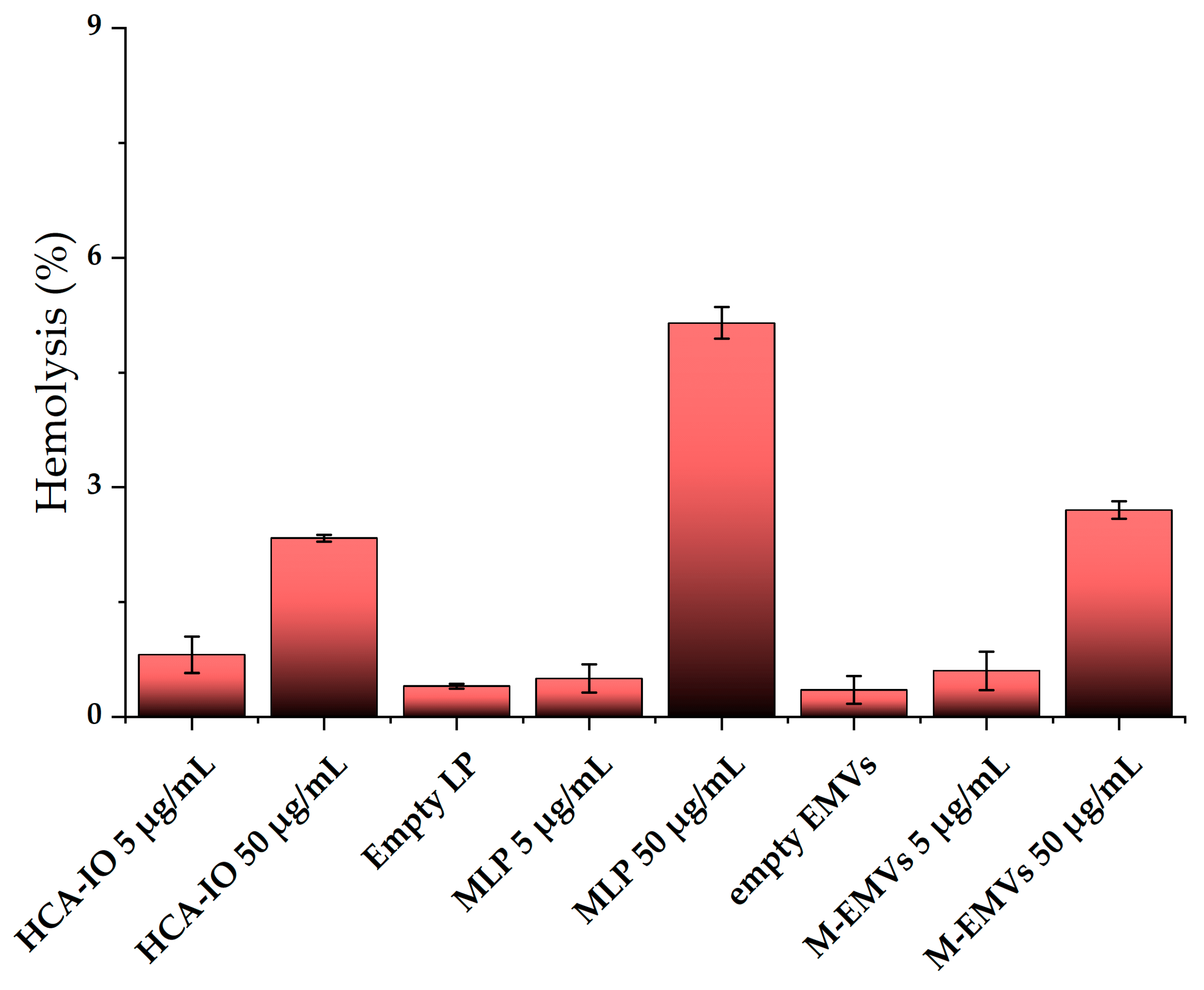Magneto-Erythrocyte Membrane Vesicles’ Superior T2 MRI Contrast Agents to Magneto-Liposomes
Abstract
1. Introduction
2. Materials and Methods
2.1. Chemicals
2.2. Synthesis of IO NPs
2.3. Preparation of HCA-Coated IO NPs
2.4. Preparation of Magneto-Liposomes
2.5. Preparation of Magneto-EMVs
2.6. Hydrodynamic Diameter and Zeta Potential Measurements
2.7. Magnetic Measurements
2.8. Inductively Coupled Plasma Mass Spectrometry (ICP-MS)
2.9. Phospholipid Assay
2.10. Transmission Electron Microscopy (TEM) and Cryogenic Transmission Electron Microscopy (cryo-TEM)
2.11. NMR Relaxivity Measurements
2.12. MRI Phantom Experiments
2.13. Hemotoxicity Study
3. Results and Discussion
3.1. Preparation of Hydrophobic, OA/OLA-Coated IO NPs
3.2. Characterization of Magneto-Liposomes and Magneto-EMVs
3.3. NMR Relaxivity and MRI Measurements
3.4. Hemotoxicity Study
4. Conclusions
Author Contributions
Funding
Conflicts of Interest
References
- Shin, T.; Choi, Y.; Kim, S.; Cheon, J. Recent advances in magnetic nanoparticle-based multi-modal imaging. Chem. Soc. Rev. 2015, 44, 4501–4516. [Google Scholar] [CrossRef]
- Slichter, C.P. Principles of Magnetic Resonance; Springer Series in Solid-State Sciences; Springer: Berlin/Heidelberg, Germany, 1990; Volume 1, ISBN 978-3-642-08069-2. [Google Scholar]
- Merbach, A.; Helm, L.; Tóth, É. The Chemistry of Contrast Agents in Medical Magnetic Resonance Imaging: Second Edition; John Wiley & Sons: Hoboken, NJ, USA, 2013; ISBN 9781119991762. [Google Scholar]
- Boros, E.; Gale, E.M.; Caravan, P. MR imaging probes: Design and applications. Dalt. Trans. 2015, 44, 4804. [Google Scholar] [CrossRef]
- Wang, Y.-X.J. Superparamagnetic iron oxide based MRI contrast agents: Current status of clinical application. Quant. Imaging Med. Surg. 2011, 1, 35–40. [Google Scholar] [PubMed]
- Daldrup-Link, H.E. Ten things you might not know about iron oxide nanoparticles. Radiology 2017, 284, 616–629. [Google Scholar] [CrossRef] [PubMed]
- Daldrup-Link, H.E.; Rydland, J.; Helbich, T.H.; Bjørnerud, A.; Turetschek, K.; Kvistad, K.A.; Kaindl, E.; Link, T.M.; Staudacher, K.; Shames, D.; et al. Quantification of Breast Tumor Microvascular Permeability with Feruglose-enhanced MR Imaging: Initial Phase II Multicenter Trial. Radiology 2003, 229, 885–892. [Google Scholar] [CrossRef] [PubMed]
- Zhang, W.; Liu, L.; Chen, H.; Hu, K.; Delahunty, I.; Gao, S.; Xie, J. Surface impact on nanoparticle-based magnetic resonance imaging contrast agents. Theranostics 2018, 8, 2521–2548. [Google Scholar] [CrossRef]
- Avasthi, A.; Caro, C.; Pozo-Torres, E.; Leal, M.P.; García-Martín, M.L. Magnetic Nanoparticles as MRI Contrast Agents. Top. Curr. Chem. 2020, 378, 40. [Google Scholar] [CrossRef]
- Caspani, S.; Magalhães, R.; Araújo, J.P.; Sousa, C.T. Magnetic nanomaterials as contrast agents for MRI. Materials 2020, 13, 2586. [Google Scholar] [CrossRef]
- Rahim, S.; Jan Iftikhar, F.; Malik, M.I. Biomedical applications of magnetic nanoparticles. In Metal Nanoparticles for Drug Delivery and Diagnostic Applications; Elsevier Inc.: Amsterdam, The Netherlands, 2020; pp. 301–328. ISBN 9780128169605. [Google Scholar]
- Kostevšek, N.; Cheung, C.C.L.; Serša, I.; Kreft, M.E.; Monaco, I.; Franchini, M.C.; Vidmar, J.; Al-Jamal, W.T. Magneto-liposomes as MRI contrast agents: A systematic study of different liposomal formulations. Nanomaterials 2020, 10, 889. [Google Scholar] [CrossRef] [PubMed]
- Li, R.; He, Y.; Zhang, S.; Qin, J.; Wang, J. Cell membrane-based nanoparticles: A new biomimetic platform for tumor diagnosis and treatment. Acta Pharm. Sin. B 2018, 8, 14–22. [Google Scholar] [CrossRef]
- Phua, K.K.L.; Boczkowski, D.; Dannull, J.; Pruitt, S.; Leong, K.W.; Nair, S.K. Whole Blood Cells Loaded with Messenger RNA as an Anti-Tumor Vaccine. Adv. Healthc. Mater. 2014, 3, 837–842. [Google Scholar] [CrossRef] [PubMed]
- Antonelli, A.; Sfara, C.; Manuali, E.; Bruce, I.J.; Magnani, M. Encapsulation of superparamagnetic nanoparticles into red blood cells as new carriers of MRI contrast agents. Nanomedicine 2011, 6, 211–223. [Google Scholar] [CrossRef] [PubMed]
- Rao, L.; Bu, L.L.; Xu, J.H.; Cai, B.; Yu, G.T.; Yu, X.; He, Z.; Huang, Q.; Li, A.; Guo, S.S.; et al. Red Blood Cell Membrane as a Biomimetic Nanocoating for Prolonged Circulation Time and Reduced Accelerated Blood Clearance. Small 2015, 11, 6225–6236. [Google Scholar] [CrossRef] [PubMed]
- Antonelli, A.; Pacifico, S.; Sfara, C.; Tamma, M.; Magnani, M. Ferucarbotran-loaded red blood cells as long circulating MRI contrast agents: First in vivo results in mice. Nanomedicine 2018, 13, 675–687. [Google Scholar] [CrossRef] [PubMed]
- Perrault, S.D.; Walkey, C.; Jennings, T.; Fischer, H.C.; Chan, W.C.W. Mediating tumor targeting efficiency of nanoparticles through design. Nano Lett. 2009, 9, 1909–1915. [Google Scholar] [CrossRef]
- Ma, G.; Kostevšek, N.; Monaco, I.; Ruiz, A.; Markelc, B.; Cheung, C.C.L.; Hudoklin, S.; Kreft, M.E.; Hassan, H.A.F.M.; Barker, M.; et al. PD1 blockade potentiates the therapeutic efficacy of photothermally-activated and MRI-guided low temperature-sensitive magnetoliposomes. J. Control. Release 2021, 332, 419–433. [Google Scholar] [CrossRef]
- Sun, S.; Zeng, H.; Robinson, D.B.; Raoux, S.; Rice, P.M.; Wang, S.X.; Li, G. Monodisperse MFe2O4 (M = Fe, Co, Mn) nanoparticles. J. Am. Chem. Soc. 2004, 126, 273–279. [Google Scholar] [CrossRef]
- Kostevšek, N.; Hudoklin, S.; Kreft, M.E.; Serša, I.; Sepe, A.; Jagličić, Z.; Vidmar, J.; Ščančar, J.; Šturm, S.; Kobe, S.; et al. Magnetic interactions and: In vitro study of biocompatible hydrocaffeic acid-stabilized Fe-Pt clusters as MRI contrast agents. RSC Adv. 2018, 8, 14694–14704. [Google Scholar] [CrossRef]
- Virtanen, J.A.; Cheng, K.H.; Somerharju, P. Phospholipid composition of the mammalian red cell membrane can be rationalized by a superlattice model. Proc. Natl. Acad. Sci. USA 1998, 95, 4964–4969. [Google Scholar] [CrossRef] [PubMed]
- Nelson, G.J. Lipid composition of erythrocytes in various mammalian species. Biochim. Biophys. Acta (BBA)/Lipids Lipid Metab. 1967, 144, 221–232. [Google Scholar] [CrossRef]
- Morales, M.P.; Veintemillas-Verdaguer, S.; Serna, C.J. Magnetic properties of uniform g-Fe2O3 nanoparticles smaller than 5 nm prepared by laser pyrolysis. J. Mater. Res. 1999, 14, 3066–3072. [Google Scholar] [CrossRef]
- Bahmani, B.; Bacon, D.; Anvari, B. Erythrocyte-derived photo-theranostic agents: Hybrid nano-vesicles containing indocyanine green for near infrared imaging and therapeutic applications. Sci. Rep. 2013, 3, 2180. [Google Scholar] [CrossRef]
- Nakamura, K.; Yamashita, K.; Itoh, Y.; Yoshino, K.; Nozawa, S.; Kasukawa, H. Comparative studies of polyethylene glycol-modified liposomes prepared using different PEG-modification methods. Biochim. Biophys. Acta Biomembr. 2012, 1818, 2801–2807. [Google Scholar] [CrossRef]
- Fernandes, H.P.; Cesar, C.L.; Barjas-Castro, M. de L. Electrical properties of the red blood cell membrane and immunohematological investigation. Rev. Bras. Hematol. Hemoter. 2011, 33, 297–301. [Google Scholar] [CrossRef] [PubMed]
- Kuo, Y.C.; Wu, H.C.; Hoang, D.; Bentley, W.E.; D’Souza, W.D.; Raghavan, S.R. Colloidal Properties of Nanoerythrosomes Derived from Bovine Red Blood Cells. Langmuir 2016, 32, 171–179. [Google Scholar] [CrossRef]
- Chhabria, V. Development of Nanosponges from Erythrocyte Ghosts for Removal of Streptolysin-O and α Haemolysin from Mammalian Blood. Ph.D. Thesis, University of Central Lancashire, Preston, UK, 2017. [Google Scholar]
- Almgren, M.; Edwards, K.; Karlsson, G. Cryo transmission electron microscopy of liposomes and related structures. Colloids Surf. A Physicochem. Eng. Asp. 2000, 174, 3–21. [Google Scholar] [CrossRef]
- Amstad, E.; Kohlbrecher, J.; Müller, E.; Schweizer, T.; Textor, M.; Reimhult, E. Triggered release from liposomes through magnetic actuation of iron oxide nanoparticle containing membranes. Nano Lett. 2011, 11, 1664–1670. [Google Scholar] [CrossRef]
- Li, J.; Shi, X.; Shen, M. Hydrothermal Synthesis and Functionalization of Iron Oxide Nanoparticles for MR Imaging Applications. Part. Part. Syst. Charact. 2014, 31, 1223–1237. [Google Scholar] [CrossRef]
- Li, Z.; Yi, P.W.; Sun, Q.; Lei, H.; Li Zhao, H.; Zhu, Z.H.; Smith, S.C.; Lan, M.B.; Lu, G.Q. Ultrasmall water-soluble and biocompatible magnetic iron oxide nanoparticles as positive and negative dual contrast agents. Adv. Funct. Mater. 2012, 22, 2387–2393. [Google Scholar] [CrossRef]
- Kostevšek, N. A Review on the Optimal Design of Magnetic Nanoparticle-Based T2 MRI Contrast Agents. Magnetochemistry 2020, 6, 11. [Google Scholar] [CrossRef]
- De Oliveira, S.; Saldanha, C. An overview about erythrocyte membrane. Clin. Hemorheol. Microcirc. 2010, 44, 63–74. [Google Scholar] [CrossRef] [PubMed]
- Caravan, P.; Ellison, J.J.; McMurry, T.J.; Lauffer, R.B. Gadolinium(III) Chelates as MRI Contrast Agents: Structure, Dynamics, and Applications. Chem. Rev. 1999, 99, 2293–2352. [Google Scholar] [CrossRef] [PubMed]
- Boni, A.; Ceratti, D.; Antonelli, A.; Sfara, C.; Magnani, M.; Manuali, E.; Salamida, S.; Gozzi, A.; Bifone, A. USPIO-loaded red blood cells as a biomimetic MR contrast agent: A relaxometric study. Contrast Media Mol. Imaging 2014, 9, 229–236. [Google Scholar] [CrossRef] [PubMed]





| Lipid Formulation | Size (nm) | PDI | ζ-Potential (mV) | Phospholipid Content (mM) | Fe (µg/mL) |
|---|---|---|---|---|---|
| Empty liposomes | 175 ± 5 | 0.08 ± 0.01 | −3.3 ± 0.4 | 4.5 ± 0.3 | N/A |
| Magneto-liposomes | 240 ± 4 | 0.11 ± 0.05 | −0.8 ± 0.9 | N/A | 5.32 ± 0.08 |
| Empty EMVs | 308 ± 2 | 0.12 ± 0.06 | −14.2 ± 0.8 | 0.5 ± 0.2 | N/A |
| Magneto-EMVs | 356 ± 4 | 0.16 ± 0.03 | −16.4 ± 1.2 | N/A | 0.65 ± 0.05 |
| Sample | r1 (mM−1 s−1) | r2 (mM−1 s−1) | r2/r1 Ratio |
|---|---|---|---|
| HCA-IO NPS | 1.16 ± 0.08 | 12 ± 1 | 10 |
| Magneto-liposomes | 0.32 ± 0.08 | 188 ± 2 | 587 |
| Magneto-EMVs | 0.1 | 269 ± 3 | 2690 |
Publisher’s Note: MDPI stays neutral with regard to jurisdictional claims in published maps and institutional affiliations. |
© 2021 by the authors. Licensee MDPI, Basel, Switzerland. This article is an open access article distributed under the terms and conditions of the Creative Commons Attribution (CC BY) license (https://creativecommons.org/licenses/by/4.0/).
Share and Cite
Kostevšek, N.; Miklavc, P.; Kisovec, M.; Podobnik, M.; Al-Jamal, W.; Serša, I. Magneto-Erythrocyte Membrane Vesicles’ Superior T2 MRI Contrast Agents to Magneto-Liposomes. Magnetochemistry 2021, 7, 51. https://doi.org/10.3390/magnetochemistry7040051
Kostevšek N, Miklavc P, Kisovec M, Podobnik M, Al-Jamal W, Serša I. Magneto-Erythrocyte Membrane Vesicles’ Superior T2 MRI Contrast Agents to Magneto-Liposomes. Magnetochemistry. 2021; 7(4):51. https://doi.org/10.3390/magnetochemistry7040051
Chicago/Turabian StyleKostevšek, Nina, Patricija Miklavc, Matic Kisovec, Marjetka Podobnik, Wafa Al-Jamal, and Igor Serša. 2021. "Magneto-Erythrocyte Membrane Vesicles’ Superior T2 MRI Contrast Agents to Magneto-Liposomes" Magnetochemistry 7, no. 4: 51. https://doi.org/10.3390/magnetochemistry7040051
APA StyleKostevšek, N., Miklavc, P., Kisovec, M., Podobnik, M., Al-Jamal, W., & Serša, I. (2021). Magneto-Erythrocyte Membrane Vesicles’ Superior T2 MRI Contrast Agents to Magneto-Liposomes. Magnetochemistry, 7(4), 51. https://doi.org/10.3390/magnetochemistry7040051








